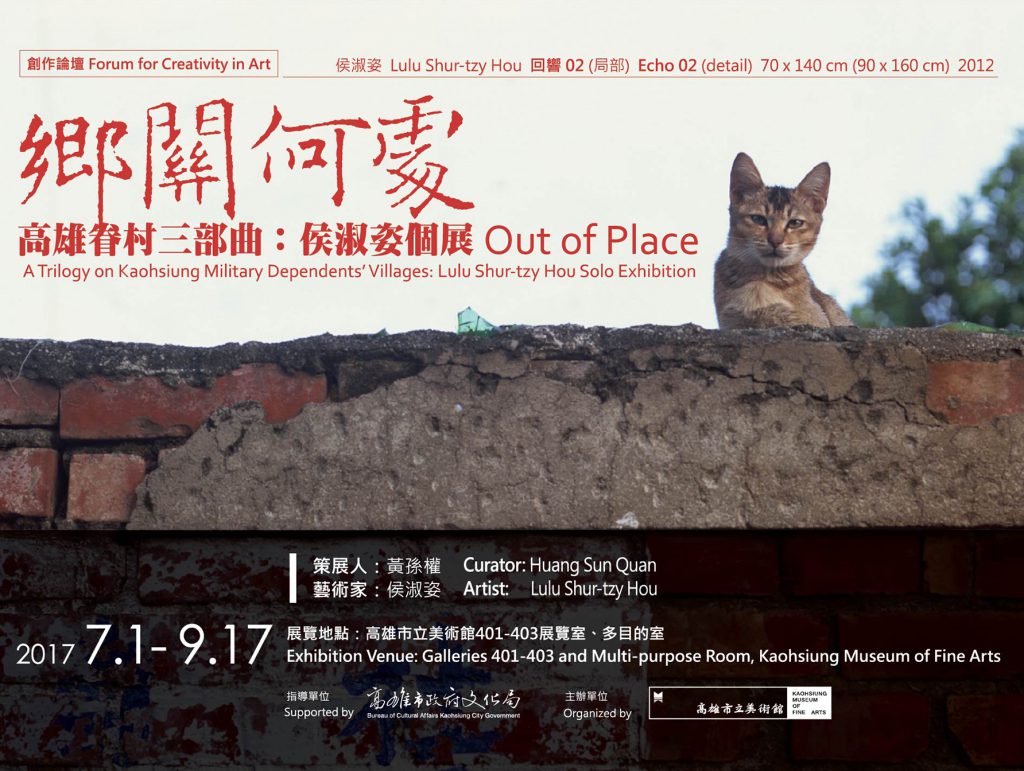
展覽介紹|
2009年2月,藝術家侯淑姿因投入高雄左營的眷村調查研究而進入了高雄眷村,也走入了眷村居民的生命歷程。八年多來,她以天職般的使命感介入眷村文化保存的工作,產生了與眷村居民休戚與共的患難情感。在高雄眷村,侯淑姿與地方空間相遇,與不同生命的歷程交織,開創了一種跨越紀實攝影、田野敘事、社會性實踐的多重界限的藝術。
In February 2009, artist Lulu Shur-tzy Hou visited military dependents’ villages in Kaohsiung as part of a survey research on the city’s Zuoying Military Dependents’ Villages, which brought her into contact with the lives of military dependents’ village residents. Throughout more than eight years, she has been driven by a deep sense of mission to involve herself in the effort to preserve the culture of military dependents’ villages, and as a result has personally shared the trials and tribulations experienced by village residents. In Kaohsiung’s military dependents’ villages, Hou’s encounters with local spaces and her life interwoven with different courses of life have inspired her to develop a style of multi-domain art encompassing and transcending documentary photography, field narratives, and social practice.
本展為策展人黃孫權與藝術家侯淑姿繼2010年高美館的創作論壇《望向彼方:亞洲新娘之歌》後再次合作。此高雄眷村三部曲是為藝術家多年深入高雄左營與鳳山眷村創作的總結。藉由策展人稱之為「雙眸」風格的正負影像並置、主客觀點並陳的表現手法,作品呈現了在眷改條例下幾經波折動盪的離散滄桑,以及藝術家與眷村居民在對話中所交疊的當代史心聲。
This exhibition represents a further collaborative effort involving curator Huang Sun Quan and the artist in the wake of the “Look toward the Other Side: Song of Asian Foreign Brides in Taiwan,” which was held in 2010 under the auspices of Forum for Creativity in Art at Kaohsiung Museum of Fine Arts. A Trilogy on Kaohsiung Military Dependents’ Villages summarizes the artist’s creative work involving Kaohsiung’s Zuoying and Fengshan military dependents’ villages over the course of many years. Employing the juxtaposition of positive and negative image pairs — which is termed a “Double-gaze” style by the curator, the artist superimposes subjective and objective viewpoints. Her work displays the dispersion and disruption of the military dependents’ villages, the turmoil and transience of the village residents’ lives as well as their appeals for “going back home” due to the improper execution of “Act for Rebuilding Old Quarters for Military Dependents,” and creates a contemporary epic of local history interwoven with the artist’s narratives and her dialogue with the residents.
自2013年的《我們在此相遇》、2015年《長日將盡》,到新近完成的《鄉關何處》系列,此三部曲系列作品映照出眷村的不同命運—人物全非的、房舍依舊但人回不去的、仍奮力存活的家園。藝術家透過攝影記錄、訪談調查、行動介入,在社會性空間裡生產藝術;於田野間、於藝術家以身為度之際、於居民向公共歷史說話中生產作品。
The trilogy, which consists of the “Here is where we meet” series published in 2013, the “Remains of the Day” series published in 2015 and the recently-completed “Out of Place” series, reflects different fates of military dependents’ villages: people and houses all gone, houses still present but no people living in them, and still-thriving communities. The artist relies on her photographic record, interviews, and active intervention to produce art in social spaces. In the field, the artist has deep empathy with the residents. Going together, they create a public history and start a conversation with Taiwan’s societies.
藝術家的攝影並非再現眷村,而是創造我們與眷村的共感,讓鮮少被論及的眷村女性得以顯露其生命歷程,並揭示出全台消亡的眷村乃公共住宅私有化的歷史。長期致力於從女性觀點書寫與創作的侯淑姿,令我們聆聽眷村女性的聲音,看到她們與國家、家園、男性愛恨糾纏的容顏。同時令我們意識到眷村不是鄉愁,而是一段讓台灣社會聚落失去一切共有 ( 家園、記憶、共同生活 ) 的殘酷歷史的一部分。也因此,此展覽能夠使得我們從「應當去那兒住」( there that I should like to live )的感受性—巴特認為攝影最好的品質—出發,思考逼問台灣土地上每一個人的、而非僅是眷村住戶的問題:若「地景的本質是:家」( the essence of the landscape: heimlich ),那我們的家在哪裡?
The artist’s photographs are not a representation of military dependents’ villages, but rather the creation of a shared feeling among all of us, not just the military dependents’ villages. These works are sketches of an after-war migration history, which reveal the traumatic experiences related to local feelings and living histories due to urban development, and represent a collective movement of the residents of military dependents’ villages to “have a Home.” Having long striven to write and create art from a female perspective, the artist lets us hear the voices of women of the military dependents’ villages; in her art, we see these women’s complicated love/hate relationships with their country, their homeland, and their men. At the same time, her art makes us conscious of the fact that the military dependents’ villages do not represent nostalgia. In fact, the disappearing course of military dependents’ villages across Taiwan are equivalent to the history of the privatization of public housing in Taiwan, as well as the cruel historical process in which some major social communities in Taiwan lost all their common property (home, memories, communal life.)
As such, this exhibition is able to help us proceed from having a sensation of “there that I should like to live” — which French philosopher Roland Barthes considers the best quality of photography — to thinking about a question that not only the residents of military dependents’ villages but also each and every person in Taiwan should be forced to answer: If “such then would be the essence of the landscape: heimlich (meaning home and clandestine in German),” where then is our home?
展覽資訊|
展期Duration|2017.07.01~09.17
策展人Curator|黃孫權Huang Sun-Quan
地點Venue|高雄市立美術館Kaohsiung Museum of Fine Arts.
開幕暨記者會Opening|2017.07.08 14:00~14:50
座談活動Talk|2017.07.08 15:00~16:00

